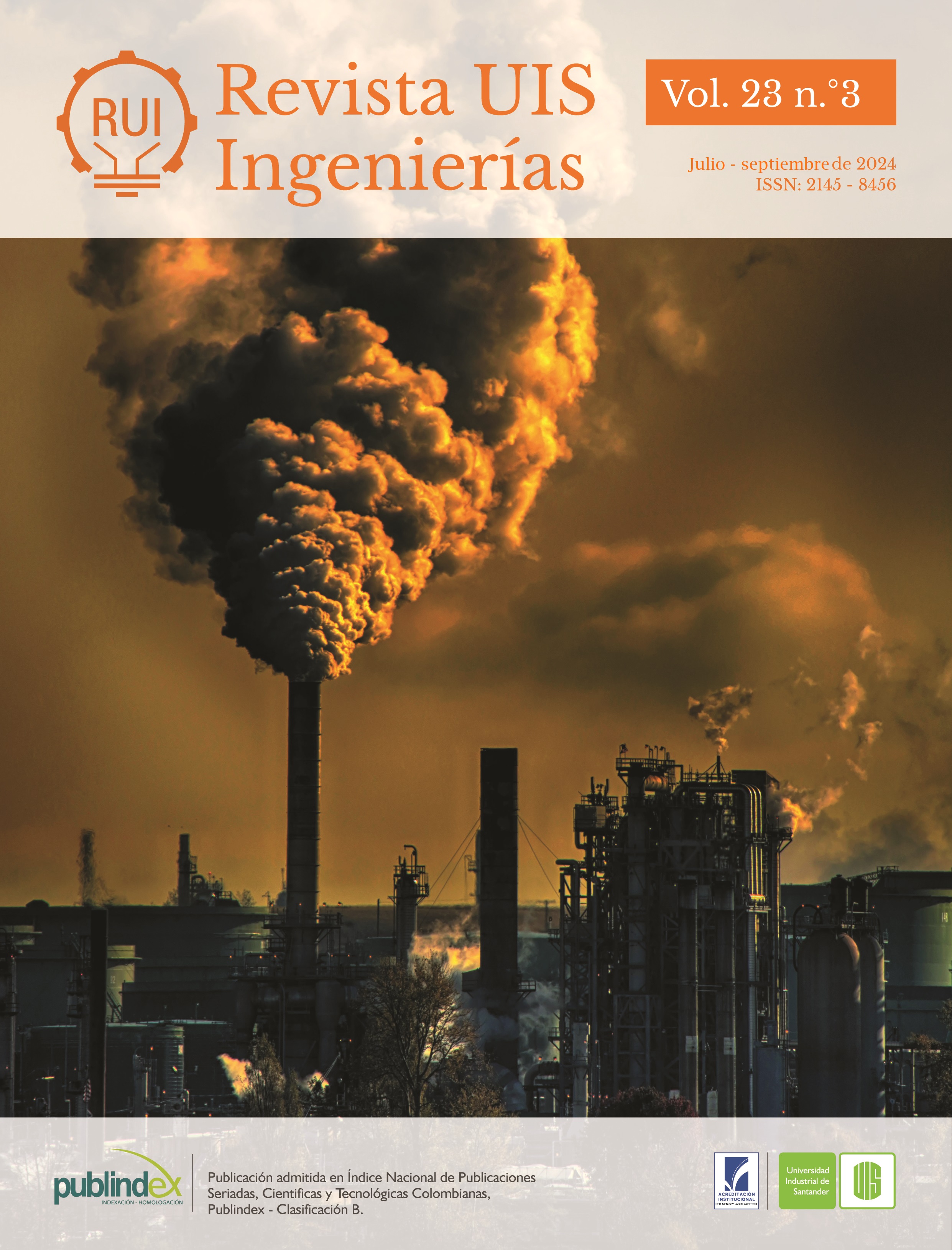Numerical Simulation of Flow through a Laboratory Channel Gate using ANSYS Fluent
Published 2024-08-11
Keywords
- ANSYS Fluent,
- Calibration,
- Channel gate,
- Experimental and numerical comparison,
- Flow analysis in gates
- Numerical modeling,
- Turbulence model,
- Mesh resolution,
- Validation ...More
How to Cite
Copyright (c) 2024 Revista UIS Ingenierías

This work is licensed under a Creative Commons Attribution-NoDerivatives 4.0 International License.
Abstract
Flow studies in control structures require the development of nonlinear differential equations that have no analytical solution but can be approximated by applying the finite volume method in mathematical models such as Fluent. This article presents a comparative analysis between a numerical model and a physical model of water flow in a laboratory channel using ANSYS Fluent. The scope of the study includes the development of a 2D model of the laboratory channel with a control section of a sliding flat rectangular gate and the mathematical development of the Navier-Stokes equations to model a biphasic flow of water and air throughout the computational domain, using appropriate boundary conditions. The methodology employed numerical simulation techniques using ANSYS Fluent, applying the finite volume method to solve the flow equations, and experimental techniques through direct measurements taken in the laboratory. The results demonstrate a 95.46% similarity between the mathematical modeling, direct measurements, and analytical calculations. Variables such as discharge coefficient, flow profiles, velocities at different points in the channel, and pressure distribution remained consistent throughout the computational domain. In conclusion, the advantages of the numerical model over the physical model are highlighted, emphasizing its efficiency and cost-effectiveness by allowing easy and simultaneous modifications in problem configurations, turbulence models, and boundary conditions. Additionally, the importance of the numerical model is highlighted by providing more accurate results than direct measurements made on the physical model, especially in turbulent areas and in the interaction of biphasic flow in the channel and gate. Finally, it is important to include a sensitivity analysis and mesh refinement in the mathematical model in such studies to avoid fluctuations near the gate where the section contracts.
Downloads
References
- V. C. Patel, W. Rodi, G. Scheuerer, “Turbulence Models for Near-Wall and Low Reynolds Number Flows: A Review,” AIAA Journal, vol. 23, no. 9, 2017, doi: https://doi.org/10.2514/3.9086
- J. Kim, P. Moin, R. Moser, “Turbulence statistics in fully developed channel flow at low Reynolds number,” Journal of Fluid Mechanics, vol. 177, pp. 133-166, 1987, doi: https://doi.org/10.1017/S0022112087000892
- J.A. Mora, G.R. Granados, “Modelación hidrodinámica bi-y tridimensional del nuevo canal con disipador de energía del laboratorio de la Escuela Colombiana de Ingeniería, utilizando Ansys Fluent,” Revista de la Escuela Colombiana de Ingeniería, no. 110, pp. 23-35, 2018.
- Y. Martinez, J. A. Echeverria, “Modelación del flujo en una compuerta a través de las pérdidas de energía relatives de un salto hidráulico sumergido. primera parte,” Ingeniería Hidráulica y Ambiental, vol. 23, no. 3, pp. 65, 2002, https://link.gale.com/apps/doc/A146838687/IFME?u=anon~cdf70ab8&sid=googleScholar&xid=042cc599
- A.I. Rajaa, A. H. Kamel, “Performance Study of Fluent-2D and Flow-3D Platforms in the CFD Modeling of a Flow Pattern Over Ogee Spillway,” Anbar Journal of Engineering Science, vol. 11, no. 2, pp. 221-230, 2020, doi: https://doi.org/10.37649/aengs.2020.171262
- A. Villamizar Hernández, “Aplicación de un modelo turbulento bidimensional para la simulación de flujo a superficie libre en un canal horizontal,” Universidad Nacional de Colombia, 2014.
- R. H. Pletcher, J. C. Tannehill, D. A. Anderson, Computational fluid mechanics and heat transfer, 3th ed. Boca Raton; New York; Oxon: CRC Press, Taylor & Francis Group., 2012.
- R. C. Gilmore, J. A. Marts, J. F. Brune, S. Saki, G. E. Bogin, J. W. Grubb, “Simplifying CFD modeling of longwall gobs with a modular meshing approach,” Mining Engineering, vol. 67, No. 3, pp. 68-72, 2015.
- J. Ferziger, M. Peric, Computational Methods for Fluid Dynamics. Berlin; Heidelberg; New York: Springer, 2002.
- J. D. Anderson, Computational fluid dynamics: the basics with applications, New York: McGraw-Hill, 1995.
- A. H. Otálora, G. R. Santos, “Análisis de un vertedero triangular de pared delgada con Ansys Fluent,” Revista de la Escuela Colombiana de Ingeniería, no. 103, pp. 37-46, 2016.
- J. Anderson, Fundamentals of aerodynamics, 6th ed. New York: McGraw-Hill Education, 2017.
- ANSYS, “ANSYS GUIDE User’s Guide,” Cannonsburg, 2010.
- W. K. H. Ariyaratne, E. V. P. J. Manjula, C. Ratnayake, M. C. Melaaen, “CFD approaches for modeling gas-solids multiphase flows–A review,” 9th EUROSIM & the 57th SIMS Conference, pp. 680-686, 2016, doi: https://doi.org/10.3384/ecp17142680
- I. Ibrahim, S. L. Ibrahim, S. Khan, “Flow structures in dividing open channels: a review,” IOP Conference Series: Earth and Environmental Science, vol. 437, IOP Publishing, 2020, doi: https://doi.org/10.1088/1755-1315/437/1/012008
- N. Rajaratnam, J. A. Humphries, “Turbulent non-buoyant surface jets,” Journal of Hydraulic Research, vol. 22, no. 2, pp. 103-115, 1984, doi: https://doi.org/10.1080/00221688409499387

